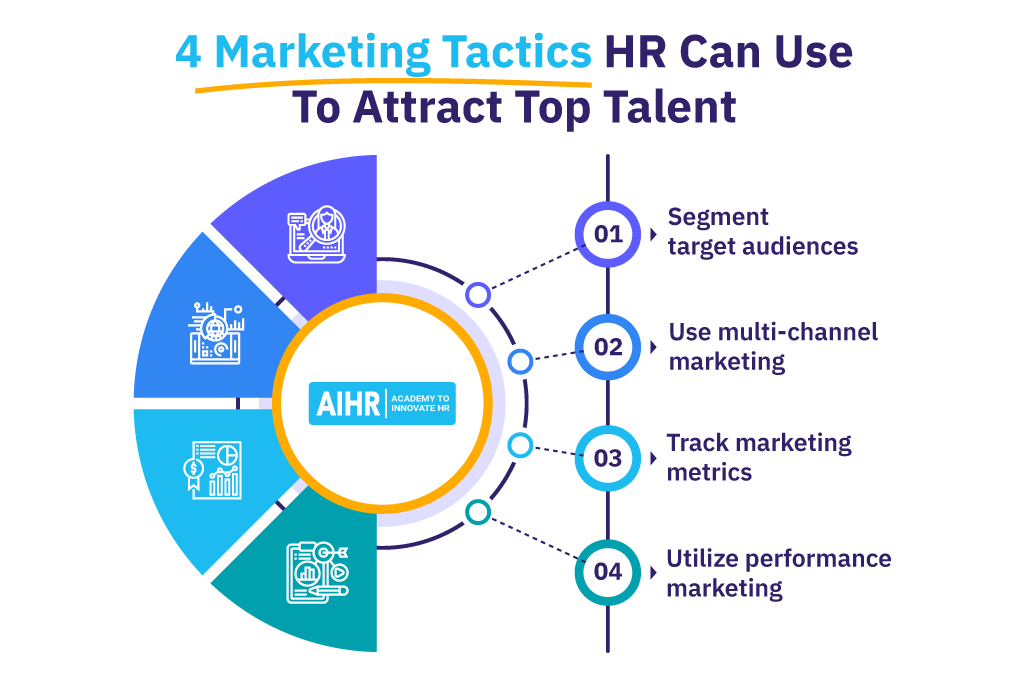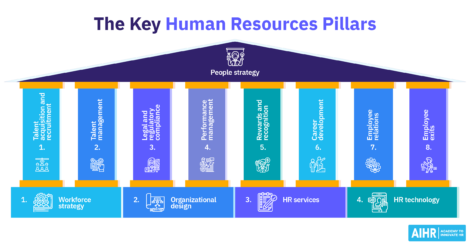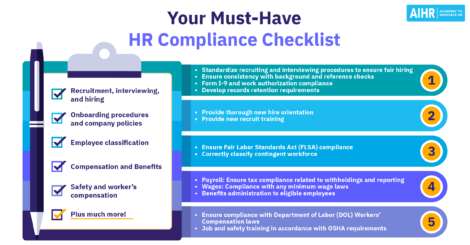HR Marketing Tactics To Attract Top Talent

When referring to HR marketing, you might immediately think about employer branding. But there are other marketing strategies and tools that HR professionals can leverage to build a successful recruitment strategy and attract top talent.
Contents
Segment your target audiences
Use multi-channel marketing to reach your audience
Utilize performance marketing
Track the right marketing metrics
In this article, we will showcase a variety of marketing activities and tools that HR can use.
Segment your target audiences
HR can leverage several general marketing tactics and tools used in marketing to find and attract the right talent. After all, the line between potential candidates and consumers is quickly becoming blurred as job prospects have access to a growing amount of appealing options within the market.
One of these marketing concepts involves segmenting your target audiences. A target audience is a group of people, usually identified by a business or marketing team, linked by common demographics, including age, gender, location, education, field of work, interests, needs, and more.
Your target audiences have different goals, needs, or aspirations. As an HR practitioner, you are probably already targeting various candidates in your recruitment strategy. Segmentation of your audience will help you target and attract the right candidates for your recruitment process.
For example, you may want to segment according to experience level, location, and industry experience.
How to define a target audience for recruitment
Most employers have three broad target audience groups:
- Current employees
- New employees
- Candidates
Let’s ignore current and new employees, as it would be more beneficial to you to develop a separate marketing strategy that targets your internal audience. This article focuses on the external market you need to attract – the top candidates you want to attract.
Since your target audience group is top candidates, let’s define the personas that best suit our ideal candidates by defining the elements of each persona. Answer some questions about your persona, such as:
- Where does your candidate live?
- What are their qualifications?
- What stage of their career do they currently find themselves in?
- What attributes do they display?
- What are their career ambitions?
- What media channels will the candidate use?
- What makes them stand out above all candidates?
Develop each persona based on your organization’s needs or goals. For example, if your organization will be growing into new regions, you may create personas based on location. If your company is pivoting into new business areas, you may develop personas based on a specific area of expertise.
Now that you have created personas specific to your organizational needs, let’s understand where we can find our target audience.
Use multi-channel marketing to reach your audience
In today’s constrained labor market, finding that top talent is more challenging than before. Which is why utilizing a multi-channel marketing approach will help you to increase your potential reach.
There are a lot of channels to choose from, and the thinking should not be to use as many as possible. Instead, identify the proper channels for your recruitment needs by determining where your best prospects spend the most time and where they’re searching for jobs.
How to decide which channel is best for you
Test to understand which platforms and the types of posts lead to the strongest engagement and conversions. Track key metrics that help you know if you’re meeting your goals.
For example, you might experiment with posting employee video testimonials on your Instagram page, stand-out employee testimonial quotes on your Twitter account, and a “day in the life of an employee” blog-style article on your website. Determine which of these gets the most engagement overall, leads to the most click-throughs to your careers page, and the most applications.
Although it may seem like you have to show up everywhere to reach your target prospects, a more focused multi-channel marketing strategy will likely produce stronger results.
Types of channels to consider
1. Social Media Marketing
With 71% of social media users saying they would recommend a brand to their network after a positive interaction with a company, HR should consider social media marketing to boost their employer brand, reach their target audience, and stand out from competitors.
Create an HR social media marketing strategy that helps you meet your goals, whether that’s an increase in the quality of job applicants, a reduction in turnover, or a faster time-to-hire rate. Start by experimenting with various channels. LinkedIn is the go-to platform for everything career-related, but other social media channels can help you reach an untapped audience.
Be consistent with your posting, ensure you interact with followers, and promptly reply to all comments and direct messages. Use social media scheduling tools like Buffer, Hootsuite, and Later to help you manage your marketing efforts, track key metrics, and stay consistent.
2. Video Marketing
In 2022, videos accounted for over 80% of all internet traffic, and Forrester Research has demonstrated that one minute of video contains the same information as a 1,800-word document. Video is processed by the brain more efficiently and effectively; plus, it’s far more engaging than written content and speaks to our ever-reducing attention span, particularly amongst millennials.
For these reasons alone, HR would be wise to create a video marketing strategy sooner rather than later. In addition, the unstable labor market and talent shortages many organizations have faced over the past few years mean that recruiters must find new, innovative ways to reach candidates and stand out from their competition. Plus, there’s no better way to showcase that you’re a modern brand of the time than by utilizing mediums such as video, which many organizations are still not doing.
How HR can use a video marketing strategy
Instead of telling people how fun it is to work at your company, use video to show this. Film your employees enjoying their day-to-day roles, interacting with colleagues, and celebrating their wins at a team meeting. Instead of telling people how diverse your organization is, use video to show them by filming a variety of employees from different backgrounds and cultures.
A written testimonial is one thing, but a video testimonial will always trump engagement and impact. Post these on social media and your careers page to attract top, well-suited candidates.
HR teams can utilize video editing tools like Apple iMovie, Lumen5, Animaker, Filmora, and Adobe to create professional-looking video content. Don’t forget to track your results. Use Youtube or Vimeo analytics to measure and track performance.
3. Email Marketing
Emails are one of the most-utilized forms of communication. The best part is that, unlike social media, your email list will be populated with subscribers who have chosen to receive updates and want to hear from you. It’s your private channel to speak to potential candidates and showcase your employer brand.HR can join forces with the marketing team and develop a separate database targeting potential candidates.
This can help boost your company’s reputation, tell people about current vacancies, and give your recruitment strategy a new burst of energy. It’s best to send this type of email less frequently than a regular newsletter (monthly or quarterly as opposed to weekly or fortnightly).
Add a call-to-action (CTA) button on your careers page so prospects can join your list. Also, run tests on subject lines and newsletter content to see what receives the highest open rates and click-through rates. Don’t forget to personalize your emails using the subscriber’s name because these tend to receive a higher open rate. Use images and videos to boost email engagement. And make sure your emails are optimized for mobile because more and more people are reading and responding to emails on their phones today.
There are also many email automation tools you can choose from, including MailChimp, ConvertKit, FloDesk, Aweber, and more. These tools offer a range of metrics to track what’s working and improve accordingly.
Utilize performance marketing
Performance marketing is a digital marketing strategy where the advertiser only pays based on a specific result, for example, when an impression, click, or sale happens. This is an ideal strategy for businesses that want to reach many people because their spending is tied to users interacting with their content.
Performance marketing includes banner ads, native and affiliate advertising, Search Engine Marketing (SEM), content marketing, and sponsored social media advertising.
HR can utilize performance marketing to scale and diversify its advertising efforts and increase the number of top candidates applying for roles. It’s also an opportunity to create fun, innovative, and memorable ads highlighting your core values and helping you make a big impression.
One example of HR teams flexing their creative muscles is when Atlassian used the power of memes to hire a group of 15 amazing web developers from all over the world. Slogans included, “Europe, we’re coming to steal your geeks” and “Cause you meet all of my koala-fications.”
Track the right marketing metrics
If you’re not tracking the right marketing metrics, then how will you know what’s working, what’s not, and where to spend your finite resources?
Here are some key marketing metrics that HR should be tracking:
- Social media reach
- Social media engagement
- Impressions (on social media, your website, or another context.)
- Keyword searches
- Click-through rate (in talent engagement emails)
- Traffic sources
- Bounce rate
- Conversion rate (e.g., how many people who visit your career page apply for a job)
- Rate of return
An all-in-one HR dashboard can help you track the metrics that are most relevant to your HR goals. This enables you to modify your campaigns and strategies accordingly.
Tools such as Cyfe and Datapine can help you set up an HR KPI dashboard, which should be used for recruiting campaigns and to gather metrics on existing employees. For example, Knotch lets you gather feedback on internal newsletters and blog posts. Similarly, having the details for all your employee benefits programs in one place makes them easily accessible to employees and enables HR to track results.
To conclude
Traditionally, HR was an operational role but is gradually shifting to a more strategic, business-driven role in the organization. HR and marketing teams are increasingly overlapping. Both can leverage marketing strategies and tools to improve the employer brand, boost awareness, and drive engagement and attraction.
Weekly update
Stay up-to-date with the latest news, trends, and resources in HR
Learn more
Related articles
Are you ready for the future of HR?
Learn modern and relevant HR skills, online














